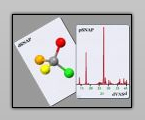Click here to find out how to optimise dSNAP and PolySNAP graphics displays for publication.
Click here for an overview comparing dSNAP, PolySNAP and PolySNAP M.
| New PolySNAP Papers: PolySNAP3: a computer program for analysing and visualizing high-throughput data from diffraction and spectroscopic sources Barr, G., Dong, W., & Gilmore, C.J, J. Appl. Cryst., (2009), 42, 965-974. High-throughput powder diffraction V: the use of Raman spectroscopy with and without X-ray powder diffraction data Gordon Barr, Gordon Cunningham, Wei Dong, Christopher J. Gilmore and Takashi Kojima J. Appl. Cryst. (2009). 42, 706–714 |
Introduction
PolySNAP3 is a computer program for the classification of powder diffraction, spectroscopic and/or raw numerical data either separately or combined. Cluster analysis, multivariate data analysis and extensive data visualiza- tion routines are used to automatically classify the patterns into groups, validate the classification, and thus identify polymorphs, mixtures and salts.
PolySNAP 3 offers
more than automation of existing procedures:
- Drastic reduction of analysis efforts and time while increasing sample throughput
- Allowing laboratory staff to concentrate only on significant results, shifting the focus from redundant to effective work.
It is a 4th generation pattern-matching program, and provides an easy to use interface to several powerful and novel statistical methods to rank patterns in order of their similarity to any selected sample, allowing knowns as well as unknowns to be quickly identified.
In quantitative mode,
given a
mixture pattern and potenial pure phase patterns, PolySNAP can identify
which patterns are in the mixture, and quantify their proportions
quickly and easily.
The pattern matching is based on
a statistical comparison of each measured datapoint in each pattern.
This true full pattern
analysis approach takes full advantage of all pattern
information including:
- Presence or absence of peaks
- Peak shoulders
- Background regions and more
Consequently,
it provides for the most reliable and accurate results possible, even
for data of poor quality, as it minimises effects due to factors such
as preferred orientation and crystallite statistics.
The
pattern matching methods allow:
- Identification of both known and unknown samples
- have I seen this sample before?
- is it new or a mixture?
- Quantitative analysis
- what is in my mixture?
- Quality control
- am I making what I think I'm making?

Primary Program References
PolySNAP3: a computer program for analysing and visualizing high-throughput data from diffraction and spectroscopic sources
Barr, G., Dong, W., & Gilmore, C.J, J. Appl. Cryst., (2009), 42, 965-974.
Barr, G., Dong, W., Gilmore, C. J., J. Appl. Cryst. (2004). 37, 658–664
Other References
High-throughput powder diffraction V: the use of Raman
spectroscopy with and without X-ray powder diffraction data
Barr, G., Cunningham, G., Dong, W., Gilmore, C.J., and Kojima, T. J. Appl. Cryst. (2009). 42, 706–714
Barr, G., Dong, W. and Gilmore, C. J. J. Appl. Cryst. (2004). 37, 874-882
High-throughput powder diffraction. III. The application of full profile pattern matching and multivariate statistical analysis to round-robin-type data sets
Barr, G., Dong, W., Gilmore, C. J., Faber, J. J. Appl. Cryst. (2004). 37, 635-642
SNAP-1D: a computer program for qualitative and quantitative powder diffraction pattern analysis using the full pattern profile
Barr, G., Gilmore, C. J., Paisley, J., J. Appl. Cryst. (2004). 37, 665–668
Automation of Solid Form Screening Procedures in the Pharmaceutical Industry - How to Avoid the Bottlenecks
Storey, R., Docherty, R., Higginson, P. D., Dallman, C., Gilmore, C. J., Barr, G. and Dong, W., Cryst. Rev. (2004). 10, 45-56
High-throughput powder diffraction. II. Applications of clustering methods and multivariate data analysis
Barr, G., Dong, W. and Gilmore, C. J., J. Appl. Cryst. (2004). 37, 243-252
High-throughput powder diffraction. I. A new approach to qualitative and quantitative powder diffraction pattern analysis using full pattern profiles
Gilmore, C. J., Barr, G. and Paisley, J. J. Appl. Cryst. (2004). 37, 231-242





